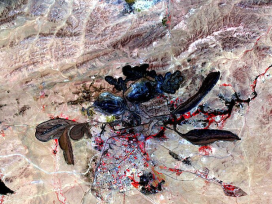“Dangerous climate change” can only be prevented if a post-Kyoto is reached at the UN Climate Change Conference in Copenhagen in December 2009 that allows for a global halving of greenhouse gas emissions by 2050. If this fails, then in the upcoming decades temperature increases can be expected that will lead to fundamental and irreversible changes in the Earth’s system. This could undermine global human development, overtax social capacities especially in developing countries, and endanger the stability of the international system.
Development politics must quickly enter uncharted conceptual territory and must link the struggle against poverty with suitable strategies for adaptation to climate change. The EU now has the chance of gaining decision-making power in both development cooperation and in energy policy on a global political as well as economic level by being the pioneers that lead the way.
Radical changes in the Earth’s system
A recent report of the Intergovernmental Panel on Climate Change (IPCC, 2007) leaves no doubt that the average increase in global warming is currently approaching 1°C compared to the pre-industrialization era and is caused mainly by the burning of fossil fuels. Due to the inertia of the climate system, a warming of between 1.5-2°C is practically unavoidable. This will have far-reaching consequences for ecological and social processes of global change in the coming two to three decades. If the attempt to agree to an effective post-Kyoto regime by the end of 2009 that allows for a 50-70 per cent reduction in global greenhouse gas emissions by 2050 fails, then a global temperature rise of 2.5 to over 5°C is likely. Climate research shows that the risk of irreversible, fundamental changes to the Earth’s system would thereby greatly increase. Regional environments and the global ecological system could radically restructure themselves, the conditions for human development could be drastically altered on a worldwide level, and the ability of societies and the international system to adapt overstrained.
Such a tipping point will be reached if, for example, continuing climate change leads to the drying up of the Amazon rainforest. This would not just have unforeseeable effects upon the natural environment – and hence on the social dynamics and the agricultural potential – of the entire Latin and Central American region; it would also lead to a release of considerable amounts of carbon dioxide and therefore further intensify climate change. Just as dramatic would be a radical transformation of the monsoon in Asia. A sea level rise of one metre would also have far-reaching consequences. New York, for example, whose location in the past has been affected by devastating storm tides once every century, would have to expect such flood disasters every four years. Extreme and formerly rare natural phenomena would become frequent around the world. Metropolises such as New York can presumably afford the necessary financial and organizational measures, unlike severely threatened megacities such as Lagos, Calcutta or Dhaka.
Unmitigated climate change could therefore release dynamics that would transform entire world regions. Such radical changes to natural environments are unparalleled in modern history and it is questionable whether individual governments, regional organizations and international agencies are capable of managing the resulting social and economic consequences. Unimpeded climate change would therefore imply a global historical experiment with unknown outcomes. The restriction of global warming and its effects must be a central concern of forward-looking world politics, since what is at stake is international stability and sustainable global development.
Climate change undermines the chances for development
Even without the commencement of radical system discontinuities, the foreseeable environmental changes that would take place with an average global warming of 1.5-3°C would affect the development perspectives of some seven billion people. Developing countries in Africa, Asia and South America, that typically have fewer capacities for adaptation at their disposal than developed countries, will be affected to a much higher degree.
Africa, with its particular sensitivity with regard to climatic variability combined with socioeconomic as well as political stress factors, is particularly endangered. The IPCC expects that by 2020 the number of people experiencing climate-induced water shortages will increase by 75-250 million. In individual countries a fall-off in yields of rain-fed agriculture of up to 50 per cent is also expected. In the Nile delta, regional food production is threatened by rising sea levels, since even a small rise leads to the salinization of important agricultural farmland.
At the same time, the demand for food, farmland and freshwater will probably increase, due to continuing population growth and immigration from the bordering dryland regions. In the Sahel region and in southern Africa, where a great many people are dependent on subsistence agriculture and rain-fed agriculture, already precarious living standards will worsen further as a result of more frequent and intensive extreme weather phenomena. In combination with the prevailing weakness of state institutions in many countries in the region, as well as complex violent conflicts and large streams of refugees, the risk of a gradual regional destabilization is high. Current endeavours in combating poverty and regional stabilization would be set back.
In Asia, the melting of Himalayan glaciers is a central problem. Apart from flooding and landslides, this primarily means a shortage of freshwater resources, which according to the IPCC could affect over one billion people in 2050. In large parts of the continent, flooding and temperature increases will impede the containment of typical tropical diseases and will probably lead to higher mortality rates. India, Pakistan and Bangladesh will be especially hard hit. The destructive storms and floods that already occur will take place more and more often and, due to rising sea levels, will unleash a much larger destructive power. Additionally, the salinization of the soil and changing monsoon patterns will affect regional food production, whose yields could decrease by up to 30 per cent by the middle of the century.
In the densely populated and notoriously conflict-ridden Gulf of Bengal, social tensions could escalate in a violent manner. In China, the economically significant southeast coast (tropical storms) and large parts of the hinterland (droughts, heat waves, desertification) will be affected especially starkly. It is hard to tell if the adaptive capacities of the state are equal to the challenges of modernization, social crises and the consequences of climate change all at once.
In South America, the accelerated melting of glaciers in the Andes, together with the changed precipitation patterns, will most likely lead to a reduction in available freshwater resources. The water resources in the conurbation of Lima, for example, depend over 80 per cent on the glaciers of the Andes. These have lost a third of their volume between 1970 and 1997 alone, and will disappear within the next decades with continuing warming. Hence, a highly populated and continually growing urban agglomeration within a desert-like environment must be supplied with a new water system in the foreseeable future. In other South American dryland areas, salinization and desertification will intensify and will affect regional food production. In addition, rising temperatures and declining soil humidity in the eastern Amazon region will probably lead to the gradual replacement of rainforest with savannah by the middle of the century.
It is clear that climate change will intensify existing development problems in many countries and regions and create new constraints for development. Forward-looking development strategies must therefore think about climate-induced changes to natural and settlement areas, as well as necessary adaptation. The more so as climate change already endangers achieving the Millennium Development Goals.
Climate-induced conflict constellations
The German Advisory Council on Global Change (WBGU) has identified four conflict constellations that are directly or indirectly influenced by the local or regional effects of global warming. The outbreak violent conflict and the dynamics it unleashes depend mainly on the problem-solving and conflict-management capacities of the countries and regions affected. In countries where ever increasing environmental stress encounters already weak governance structures as well as socioeconomic crises, there is a greater danger that social destabilization turns into violence. This could in turn affect and impair international stability.
First, a climate-induced decline in food production would lead to regional nutritional crises, thereby further undermining capacities to cope. Social destabilization and violent conflict benefit from this. The increasing global competition for agricultural farmland for the planting of biofuels could further intensify this conflict constellation.
Second, climate-induced aggravation of freshwater scarcity can lead to destabilization and violence in the absence of concepts for water management, suitable infrastructure and institutional prerequisites to avoid conflicts over allocation and distribution.
Third, climate change will increasingly lead to storm and flood catastrophes of the kind that have already led to the escalation of internal tensions in the past (e.g. in Bangladesh 1988, in Nicaragua and Honduras in 1998, and in West Bengal in 2000). Hurricanes and similar extreme weather events could unfold conflict potential, especially in the tropical developing countries of Central America and in the megacities along the southern Asian coastline, where capacities for adaptation and crisis management are largely missing.
Fourth, migration can lead to destabilization and violence wherever humans have to leave their home as a result of existential environmental changes. The risk of violent conflict escalation mainly increases in transit and target regions.
The more effective global climate policy, the better these conflict constellations can be contained. Vice versa, the risk that such conflicts escalate and spread is growing with rising global temperatures. Climate policy therefore equals preventive security policy.
An increasing burden for the international system
Unmitigated global warming generates global security risks. A cascade of endangerment becomes visible where continuing climate change gradually
– endangers human security in many countries and global regions;
– aids and abets subnational, national or regional destabilization and disruption, where especially many people are affected by insecurity and uncertainty and where nations and societies are overstrained politically and economically;
– generates climate crisis regions where high vulnerability to climate change and conflict constellations overlap; environmental stress does not stop at national borders and violent conflicts can easily spill over to neighbouring countries.
A further erosion of social order could strengthen the trend of internal and transnational violent conflicts (as opposed to inter-state warfare) that can be observed since the 1990s. Such dynamics, driven by climate change, would promote five particular trends in the current international system:
1. A critical impairment of global economics, that can result, amongst other things, from the necessary adaptation measures that will be required for safeguarding local and regional production processes and supply structures. The longer an effective climate policy is stalled, the higher the costs of coping with the consequences of climate change will be.
2. An increasing climate-induced threat to basic human needs (water, food, security) could undermine the international legitimacy of industrialised nations, who are mainly responsible for climate change. The same would go for fast-growing anchor countries such as China and India, whose emissions are rapidly increasing. Ultimately, this could limit these countries’ capacity to act at the global level.
3. An intensification of international distribution conflicts, especially with a view to the transfer of compensation payments between those mainly responsible for global warming and those mainly affected by its negative consequences.
4. A drastic increase in migration, both in the regions heavily affected by climate change and beyond, that would create problems for which humanitarian solutions must be found.
5. A proliferation of weak and fragile states that will hardly be able to protect their populations from the consequences of climate change, that would destabilize the international order as a result of eroding statehood.
With its current multilateral institutions, the international community would quickly reach its limits in the face of each of these dangers. More than ever, international structures will very quickly be overstrained if, as seems probable, these dangers accumulate and intensify each other.
Challenges for the EU
Climate change could bring the international community together if it is understood as being a threat to humanity and if the prevention of dangerous, uncontrollable global warming is initiated through an effective post-Kyoto regime (“avoiding the unmanageable”). The German government, in cooperation with the European Union, is momentarily trying to move international climate policy in this direction. The corresponding climate strategy has far-reaching consequences: the halving of the global CO2 emissions being targeted by the EU by 2050 implies the renunciation of fossil world energy systems and the build up of a global economy based mainly on renewable energy. If this turnaround fails, global warming will evoke ever more lines of conflict and disparity in international relations and will trigger manifold conflicts of distribution in and between countries: for freshwater, for land, about managing migration and further “collateral damage” resulting from climate change. Avoiding dangerous climate change under enormous time pressure is therefore the first challenge that decision makers face.
For development politics there also arises a second challenge. Existing poverty reduction programmes will have to be intertwined with suitable adaptation strategies in close cooperation with affected developing countries in order to prepare them for the now unavoidable consequences of climate change (“Managing the unavoidable”). In this respect, new conceptual trails have to be explored. Supportive measures for conflict prevention must be refined, especially in those regions that are particularly vulnerable to climate change. In addition, there has to be coordination between development politics on the one hand and technology and foreign trade policies on the other hand, in order to contribute to enabling the large and rapidly growing anchor countries to reduce their greenhouse gas emissions. All of these tasks are of considerable magnitude. To handle them successfully requires immediate and concerted action based on a division of labour.
The awareness that climate change belongs to the central challenges of the twenty-first century has risen significantly around the world. However, in order to commit the international community to joint global policy goals, three partial strategies have to be interlinked: an effective and poverty-sensitive global climate policy spurred on by credible and resolved actors; the acceleration of innovation processes within global energy supply and other areas of resource efficiency; an extension and consolidation of multilateral processes, that also include China, India and the USA, without whose cooperation a long-term, effective climate policy cannot succeed. Out of this multi-dimensional third challenge, a great opportunity, so to speak, also arises for the EU: the chance to employ its competitive advantages over other global players. If the EU takes on a plausible and credible pioneer role in international climate politics, it can become a formative global power of the twenty-first century.
Literature
IPCC (Intergovernmental Panel on Climate Change) – Working Group II (2007): Climate Change 2007: Impacts, Adaptation and Vulnerability: Fourth Assessment Report of the Intergovernmental Panel on Climate Change, Cambridge, UK
United Nations Foundation (2007): Confronting Climate Change: Avoiding the unmanageable and managing the unavoidable, Washington, DC
WBGU (German Advisory Council on Global Change) (2008): World in Transition: Climate Change as a Security Risk, London: Earthscan.






